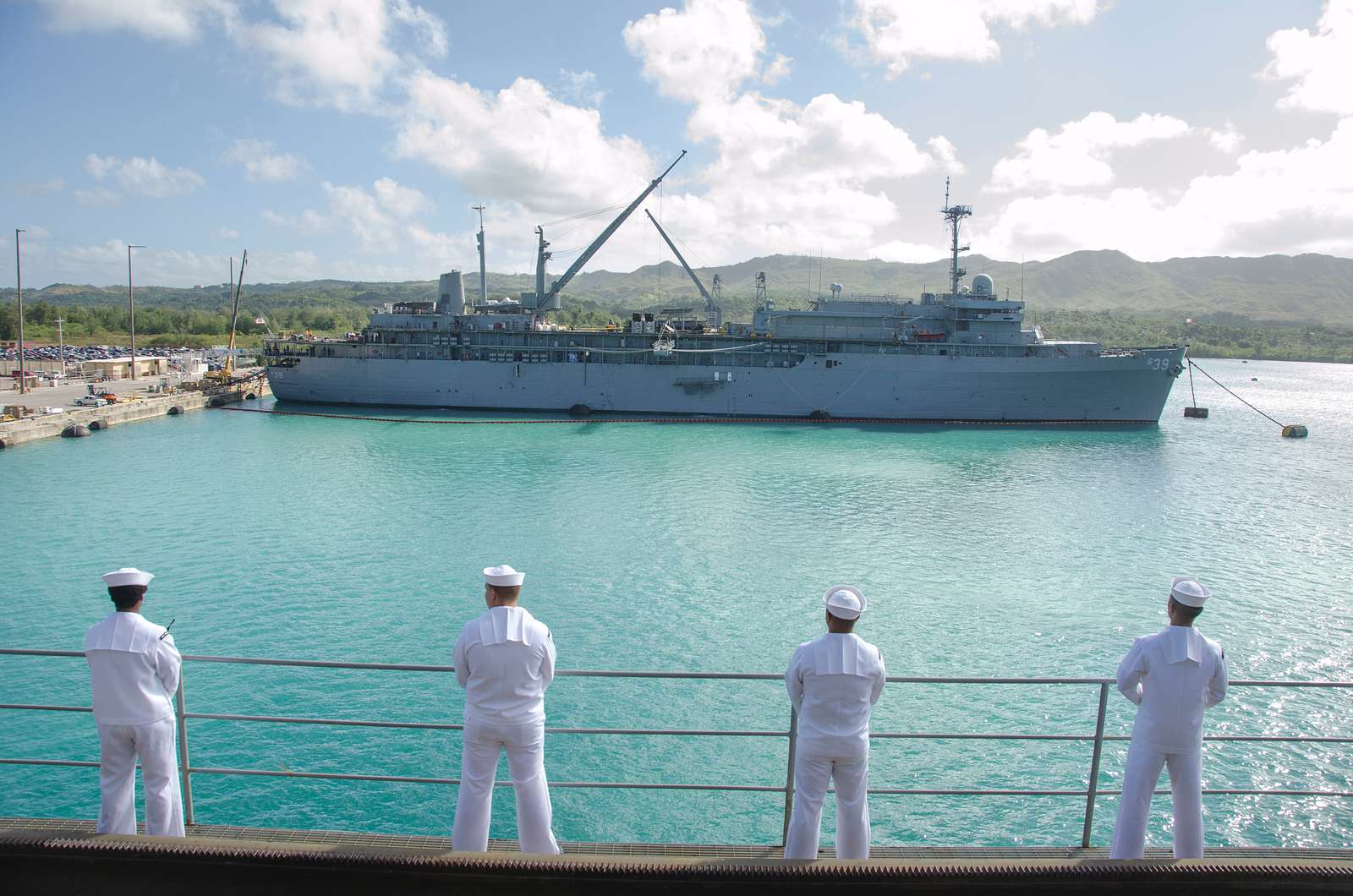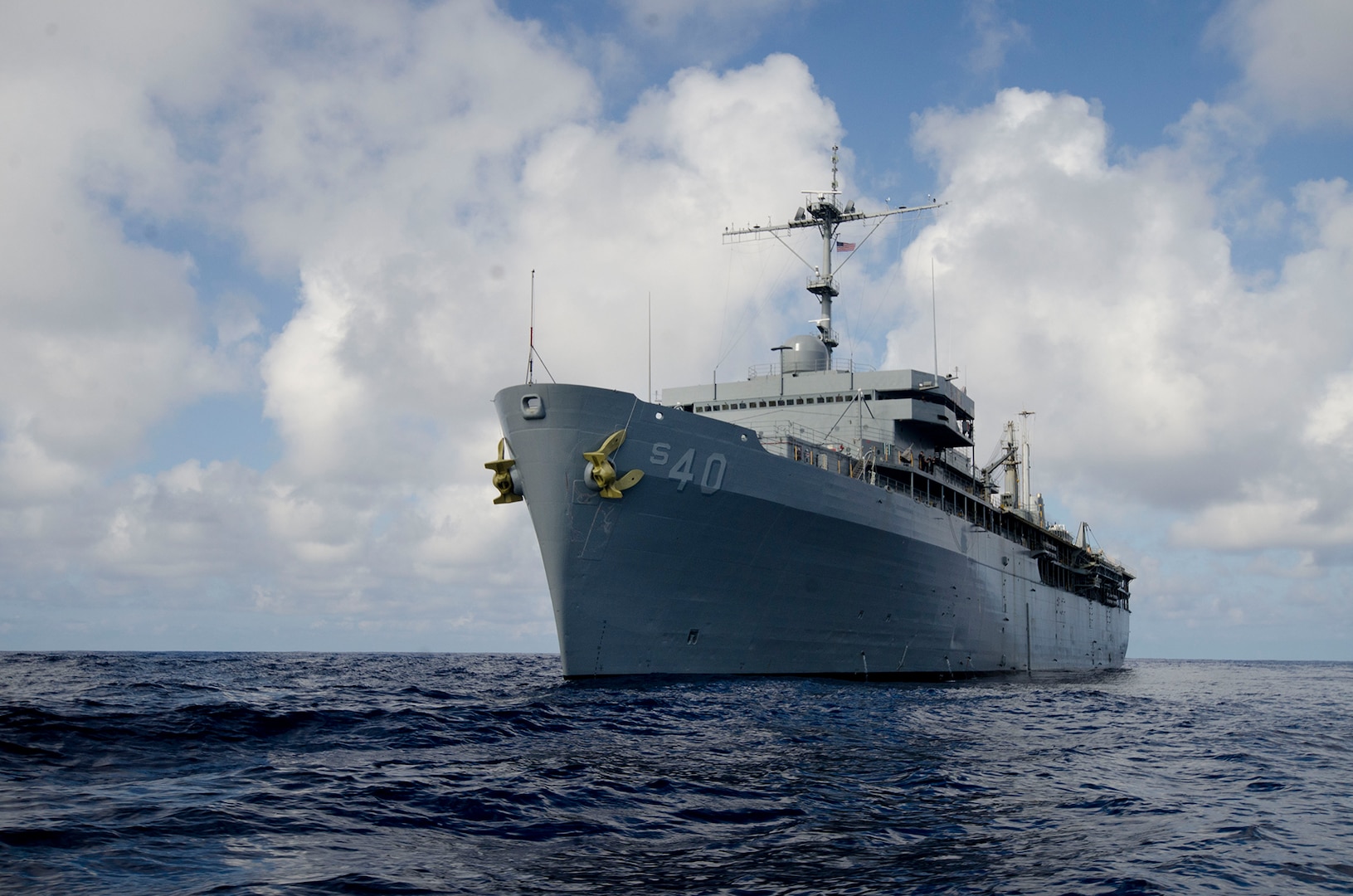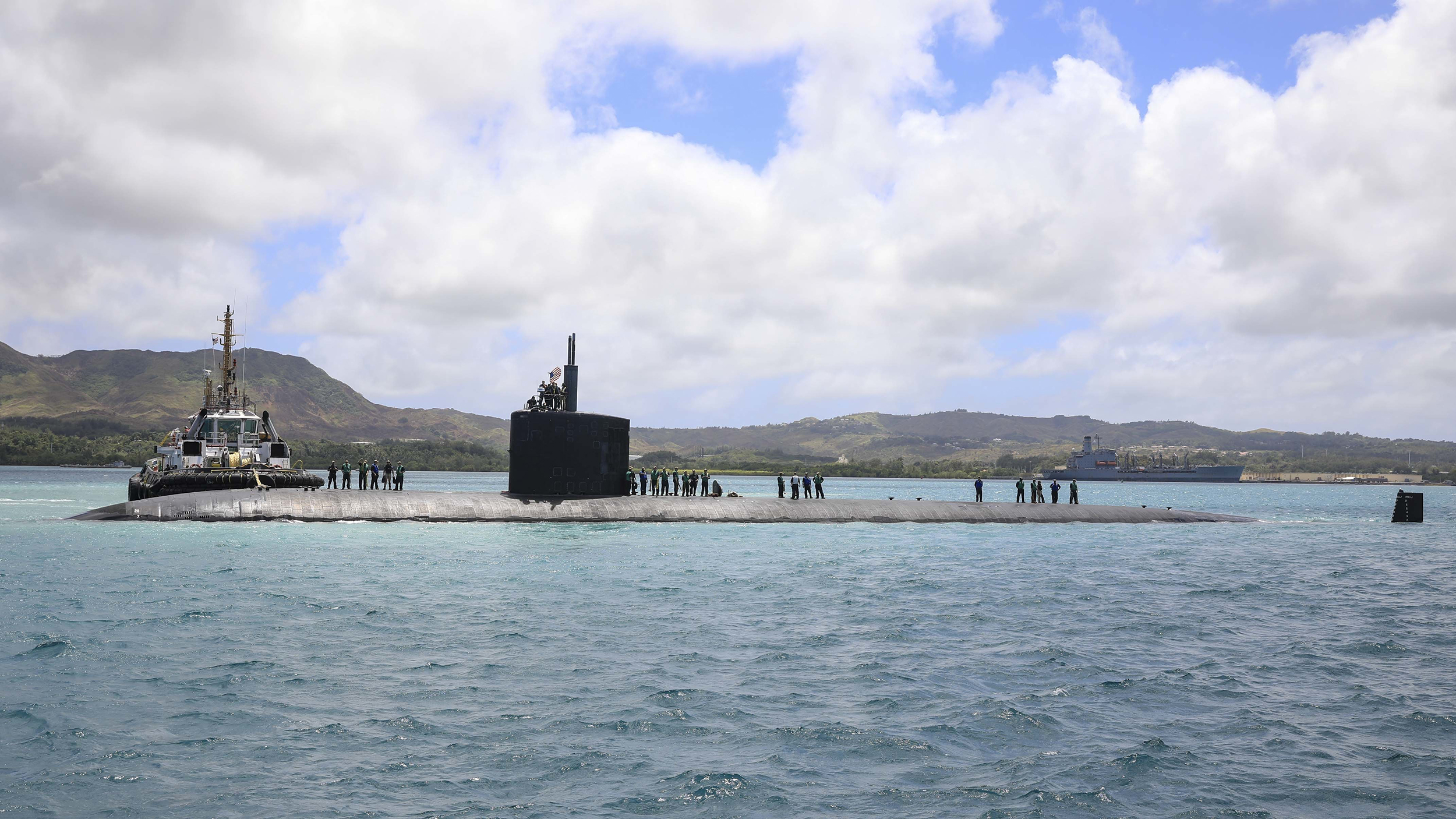Polaris Point Guam - This article requires additional citations for verification. Please help improve this article by adding citations from reliable sources. Unsourced material may be challenged and removed. Find sources: "Submarine Squadron 15" - News · Newspapers · Books · Scholar · JSTOR (April 2017) (Learn more about how and what to remove this post template)
The tugs USS Emory S. Land and USS Frank Cable in Apra Inner Harbor, Polaris Point, Naval Base Guam, homeport SUBRON 15, in 2018.
Polaris Point Guam
Submarine Squadron 15 (also known as SUBRON 15) is a submarine squadron of the United States Navy based at Naval Base Guam.
Photo] Uss Proteus With A Submarine, Apra Harbor, Guam, Early 1970s
The Fifteenth Submarine Squadron was established on 1 September 1963 at Pearl Harbor, Hawaii. The squadron was formed to take over responsibility for nuclear submarine deterrence in the Pacific from Submarine Squadron 1, which at the time operated the Regulus cruise missile submarines. Four of the seven submarines planned for the squadron were under construction at the time, while the submarine USS Proteus (AS 19) was undergoing a major overhaul at the Charleston Naval Shipyard.
During the first few months, the squadron established headquarters at Pearl Harbor and laid the groundwork for Polaris operations in the Pacific. One of the most difficult tasks was creating and executing the extensive training program required for the blue and gold crews of each submarine. To meet this requirement, close co-operation was necessary with the officers in charge of the various schools throughout the country, as well as with the commanders and crews of the submarines.
On 23 April 1964, USS Daniel Boone (SSBN 629) was commissioned at Mare Island Naval Shipyard, California. She became the flagship of the squadron and the first ballistic missile submarine assigned to the Pacific Fleet. In the early dawn of May 27, 1964, Daniel Boone surfaced from Diamond Head, Hawaii, after completing a submarine crossing from the mainland, and entered Pearl Harbor, where she became the first Polaris submarine ever to enter port. Tecumseh, Ulysses S. Grant, and Stonewall Jackson were soon commissioned. At the same time, the squadron planned conversion operations, type training, and prepared for the first Polaris patrol in the Pacific, which was to begin in early 1965.
In October 1964, the permanent assignment of Commander, Submarine Squadron Fifteen, was changed from Pearl Harbor to Guam. A rear headquarters, known as Submarine Command Squadron Five, was established at Pearl Harbor to perform the many personnel and training functions associated with manning the Polaris submarines with the most qualified and trained personnel.
File:uss White Plains (afs 4) Aground At Polaris Point, Apra Harbor, Guam (usa), 30 August 1992 (6484520).jpg
From left to right, USS Kamehameha, USS Hunley, USNS Furman, USS Proteus, and USS Stonewall Jackson at Polaris Point, Naval Base Guam, circa 1968.
On the morning of 29 November 1964, Proteus called into Apra Harbor, where she began setting up a third FBM replenishment point to support the Polaris submarines. Seven Navy ballistic missile submarines subsequently joined the USS Proteus in Guam. Benjamin Franklin and Kamehameha arrived in 1966. Mariano G. Vallejo was commissioned and assigned to Submarine Squadron Five in December 1966.
1970 was a significant period in the squadron's history. During this period, the 627/640 class units completed their Pacific service and departed for the Poseidon weapon system conversion, while the overhauled 616 class units entered service as replacements for the Pacific Fleet Strategic Deterrence Force.
On the morning of October 14, 1971, the submarine USS Hunley docked in Apra Harbor, Guam, and immediately after mooring at Polaris Point began the difficult task of unloading the Proteus. On November 2, 1971, Proteus departed Guam for the United States. Naval Shipyard, Mare Island, California, for a comprehensive shipyard overhaul.
Polaris Point Guam Hi Res Stock Photography And Images
In 1972, Hanley served as Site III support ship and flagship of Commander Submarine Squadron Five. During the summer months of 1972, Hanley performed conversion work on several SSNs in addition to the normally assigned SSBNs. This additional workload was in direct support of the increased level of national preparedness.
In January 1973, Proteus returned to Guam and replaced Hunley, which left Guam for a refit at the Puget Sound Naval Shipyard, Bremerton, Washington. The return of Proteus to Guam marked the first significant period that Proteus was absent from Guam since the establishment of SSBN REFIT Site III in 1964.
The replacement of the 616-class SSBNs with the 598/608-class SSBNs began in May 1973, when Nathan Hale left to upgrade to the Poseidon weapons system and was released by George Washington. Later, in 1973, Patrick Hry and Robert E. Lee replaced Woodrow Wilson and John Adams. The squadron included the following units: Proteus (flagship), George Washington, Patrick Hry, Robert Lee, Hry Clay, Daniel Webster, Nathan Hale, Abraham Lincoln, Thomas A. Edison, and Ethan Ohl.
During 1974, the replacement of class 616 SSBNs with 598/608 was completed. The departure of James Monroe, Daniel Webster, Gray Clay, and the arrival of Theodore Roosevelt resulted in the following units assigned to the squadron: Proteus (flagship), George Washington, Patrick Hry, Theodore Roosevelt, Robert E. Lee, Abraham Lincoln, Ethan All, Sam Houston, Thomas A. Edison, John Marshall, and Thomas Jefferson.
Los Angeles Class Fast Attack Submarine Uss Asheville (ssn 758) Moors To The Submarine Tender Uss Emory S. Land (as 39) At Polaris Point, Guam, May 31, 2022
From December 25, 1964, when Daniel Boone departed Guam on the first Polaris deterrent patrol in the Pacific, to October 1981, when Robert E. Lee returned to Pearl Harbor on the last Polaris deterrent patrol, 23 different SSBNs conducted 398 Polaris deterrent patrols. Pacific Ocean in support. strategic defense of the United States. On September 30, 1981, Submarine Squadron Fifteen ended its 8-year existence, being decommissioned in a ceremony aboard the Proteus in Apra Harbor, Guam.
In a reactivation ceremony aboard USS Frank Cable on 23 February 2001, Captain Jose R. Corpus, USN, became Commander of Submarine Squadron Fifte, formerly Commander of Submarine Group Sev Representative Guam. On this day, Submarine Squadron Five became an operational command providing administrative, logistical, and intelligence support to submarines and submarine support ships assigned to the Seventh and Fifth Fleets in response to Fleet and JCS missions.
During 2002, Submarine Squadron 5 personnel provided oversight and quality assurance monitoring during the maintenance of three forward-deployment submarines prior to their deployment to the Persian Gulf region during Operations Freedom and Noble Eagle. Submarine Squadron Fifte was also actively involved in force protection decisions and efforts from the naval station aboard COMNAVMARIANAS in the immediate aftermath of the September 11, 2001 attacks.

On 17 October and 18 December 2002, respectively, USS City of Corpus Christi and USS San Francisco arrived in Guam, completing a 14,000 nautical mile (25,928 km) inter-fleet transfer that began at the Portsmouth Naval Shipyard in Kittery, Maine .
N Yd647 0096 Polaris Point, Guam
These were the first forward-deployment and base-portable submarines. City of Corpus Christi, commanded by CDR Robert Schmidt, was the eighth fast submarine of the Los Angeles class; San Francisco, commanded by CDR Paul Pawlak, was the 24th Los Angeles class.
On July 5, 2002, Typhoon Chataan struck Guam with sustained winds of 185 km/h and gusts of 233 km/h, causing significant property damage. Submarine Squadron Five personnel assisted by sailors from Frank Cable participated in recovery operations following the typhoon.
On December 8, 2002, Super Typhoon Pongsan made landfall on Guam for over 12 hours with damaging winds of over 200 knots (370 km/h). The President of the United States declared Guam a disaster area shortly after the storm passed. This storm, one of the two largest in Guam's history, significantly affected the island's infrastructure, damaging both civilian and military facilities. A major fire at the island's gasoline depot delayed recovery efforts, limiting the availability of fuel for vehicles and emergency generators. Buildings across the island, including homes, hospitals, businesses, government and military facilities, airports and harbors, were damaged or destroyed. Due to the timely, aggressive and selfless efforts of troops assigned to units of Submarine Squadron Five, human casualties were minimized and essential services were quickly restored. Frank Cable worked at Polaris Point for two weeks, maintaining submarines brought home.
Submarine Squadron Five, Frank Cable and both assigned submarines received the Humanitarian Service Medal for their service following Typhoon Chataan and Super Typhoon Pongsan.
File:us Navy 041224 N 7293m 022 The Nuclear Powered Los Angeles Class Fast Attack Submarine Uss Houston (ssn 713) Prepares To Tie Up At Polaris Point On Naval Base Guam.jpg
On December 23, 2003, the city of Corpus Christi completed its first-ever mission in support of the operations of Commander 7th Fleet, an advanced attack submarine deployed to Guam.
On January 8, 2005, at 02:43 GMT, the San Francisco struck a seamount approximately 364 nautical miles (675 km) southeast of Guam, operating at flank speed (maximum) and a depth of over 500 ft. (152 m). The collision was so violent that the vessel almost perished; reports describe a desperate struggle for positive buoyancy to the surface after the forward ballast tanks were blown up. 23 crew members were injured, one crew member died of his injuries on January 9.
Other injuries to the crew included broken bones, lacerations and a back injury. San Francisco's forward ballast tanks and her sonar dome were severely damaged, but her inner hull was not breached and there was no damage to her nuclear reactor. She surfaced and, escorted by USCGC Galveston Island, USNS GYSGT Fred W. Stockham and USNS Kiska, as well as MH-60S Knighthawks and a P-3 Orion maritime patrol aircraft, arrived at Guam on 10 January. The US Navy immediately said there was "absolutely no reason to believe it hit another submarine or vessel". Investigation later



Post A Comment:
0 comments so far,add yours